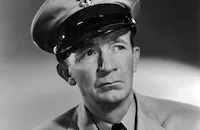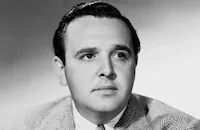King of Jazz

Brief Synopsis
Cast & Crew
Paul Whiteman
John Boles
Laura La Plante
Jeanette Loff
Glenn Tryon
William Kent
Film Details
Technical Specs

Synopsis
Charles Irwin introduces items from the Paul Whiteman scrapbook. In an animated cartoon sequence, Whiteman is "crowned" the "King of Jazz" by animals in the African jungle. Whiteman then introduces members of his band and the chorus girls. In the "My Bridal Veil" number, featuring Jeanette Loff and Stanley Smith, a young woman conjures up visions of bridal costumes through the ages. A "blackout" sketch, "Ladies of the Press," written by William Griffith, presents Laura La Plante, Jeanie Lang, Merna Kennedy, Grace Hayes and Kathryn Crawford. The Rhythm Boys (Bing Crosby, Harry Barris and Al Rinker) perform "So the Bluebirds and the Blackbirds Got Together." "It Happened in Monterey" features John Boles, Jeanette Loff, The Sisters G, George Chiles and the Russell Markert Girls, and includes a passage of "La Paloma," sung in Spanish by Nancy Torres and Loff. "In Conference," another very brief comedy sketch, presents Laura La Plante, Glenn Tryon and Merna Kennedy. Jack White performs a comedy number about wanting to own a fish store. Jeanette Loff, Stanley Smith, The Brox Sisters and The Rhythm Boys appear in the production number "A Bench in the Park." "Another Quickie--Springtime" with Slim Summerville, Yola D'Avril and Walter Brennan follows. A sketch, "All Noisy on the Eastern Front," features Walter Brennan, Paul Whiteman and others. Willie Hall performs "Pop Goes the Weasel" on a violin and finishes by playing "Stars and Stripes Forever" on a bicycle pump. In an opulent production number, Roy Bargy plays George Gershwin's "Rhapsody in Blue" on the piano, accompanied by The Sisters G and Jacques Cartier. A comedy sketch, "Oh! Forevermore" with William Kent and Walter Brennan follows. A production number, "My Ragamuffin Romeo," presents Jeanie Lang, George Chiles and dancers Don Rose and Marion Stattler. A "blackout" about a pantomime horse features Walter Brennan and Slim Summerville. In another "blackout," a couple, Glenn Tryon and Kathryn Crawford, discover that they are not legally married. "Happy Feet," a production number, features The Rhythm Boys, The Sisters G and Al Norman. Slim Summerville and George Sidney appear in a brief sketch in which Summerville seeks permission to marry Sidney's daughter. "I Like to Do Things for You," is performed by Jeanie Lang, Grace Hayes, William Kent and dancers Nell O'Day and The Tommy Atkins Sextette. "Has Anyone Seen Our Nelly?," a comedy song utilizing magic lantern slides follows. John Boles performs "The Song of the Dawn." The finale, "The Melting Pot of Music," features most of the cast and shows that in America, music from various countries, including England, Italy, Scotland, Ireland, Mexico, Russia and France, is fused into one great new rhythm, Jazz.

Cast

Paul Whiteman

John Boles

Laura La Plante

Jeanette Loff
Glenn Tryon
William Kent

Slim Summerville

Merna Kennedy
The Rhythm Boys

Bing Crosby
Harry Barris
Al Rinker
Kathryn Crawford
Beth Laemmle
Stanley Smith

Charles Irwin
George Chiles
Jack White
Frank Leslie

Walter Brennan
Churchill Ross
Johnson Arledge
Al Norman
Jacques Cartier
Paul Howard

Nell O'day
Marion Stattler
Don Rose
Russell Markert
Jeanie Lang
Roy Bargy
The Sisters G
The Brox Sisters
Nancy Torres
Grace Hayes
Yola D'avril
Willie Hall

George Sidney
Crew
Milton Ager
John Murray Anderson
Jerome Ash
Harry Barris
Robert Carlisle
James Cavanaugh
Harry De Costa
James Dietrich
James Dietrich
George Gershwin
Ferde Grofé
C. Roy Hunter
Carl Laemmle
Carl Laemmle Jr.
Walter Lantz
Edward T. Lowe Jr.
Charles Macarthur
Russell E. Markert
Hal Mohr
Billy Moll
Bill Nolan
Thomas F. O'neill
Maurice Pivar
Ray Rennahan
Billy Rose
Robert Ross
Herman Rosse
Herman Rosse
Harry Ruskin
Harold I. Smith
Mabel Wayne
Jack Yellen
Yradier

Videos
Movie Clip





Hosted Intro
Film Details
Technical Specs

Award Wins
Best Art Direction
Articles
King of Jazz
Another surprise is that this 1930 production is in color, using the two-strip process pioneered by Technicolor in the 1920s. It's an imperfect technology, making yellows look a little strange and rendering blues so impossible that the Rhapsody in Blue scene has to make do with greens. But it gives a deliciously off-kilter sheen to the fabulous sets and costumes, all concocted by Herman Rosse for director John Murray Anderson, a Broadway veteran with no other movies to his credit. One of the first sequences is the first-ever Technicolor cartoon, animated by Walter Lantz, later famous as the creator of Woody Woodpecker and known in 1930 as the impresario of Oswald the Lucky Rabbit.
A third surprise is that King of Jazz doesn't tell a story, although this wouldn't have been surprising in 1930, when a series of revue-style movies had recently arrived - so many that the fad had faded by the time this picture premiered, dimming its box-office prospects. Lacking a narrative, King of Jazz presents a series of separate acts - songs, dances, comedy sketches, novelty bits like a man playing "The Stars and Stripes Forever" on a bicycle pump - framed by a gigantic Paul Whiteman Scrap Book that intermittently fills the background. Universal Pictures originally wanted Whiteman to star in a story about a bandleader resembling himself, but Whiteman refused to do anything that resembled acting, so producer Carl Laemmle Jr. fell back on the revue format. This was an ideal vehicle for Anderson, who took the directorial reins after Paul Fejos dropped out of the project, although Fejos's major contribution to film technology - a 28-ton camera crane built at Universal in 1929 - enabled much of the film's impressive look. Three cinematographers shot the picture: Hal Mohr did the basic tasks while Ray Rennahan concentrated on color and Jerry Ash focused on camera tricks, as when musicians emerge from a toolbox and take their place on a miniature stage that then dissolves into a full-size bandstand.
Optical printing was difficult in early Technicolor, so dissolves and other fancy visuals were created in the camera. The two-strip process required enormous amounts of light, moreover, and the resulting heat was extremely hard on the performers. When the band played Rhapsody in Blue while enclosed in a massive piano, the temperature soared so high it's a wonder the musicians didn't wilt. Despite such challenges, King of Jazz is packed with razzle-dazzle, ranging from abstract swirls to extravagant props such as a colossal wedding veil held by an army of bridesmaids.
Bing Crosby made his screen debut in King of Jazz, and future star Walter Brennan shows up in some of the blackout sketches. Also present are the Russell Markert Girls, who later morphed into the Radio City Rockettes, still famous for their precision dance routines. Everyone participates in the climactic number, built around a "Melting Pot of Music" in which musicians of various nationalities demonstrate their native styles before descending into a symbolic tub representing American music as a whole. Leaving aside how unpleasant it would be to get actually melted in such a pot, this sequence reinforces the film's regrettably closed-off view of where jazz actually came from: every musician is white and the overall vision is Eurocentric in the extreme. King of Jazz is both a dazzling musical revue and a vivid reminder of the racial and ethnic tunnel vision that has long afflicted American culture.
Director: John Murray Anderson
Producer: Carl Laemmle Jr.
Screenplay: John Murray Anderson
Cinematographers: Hal Mohr, Jerry Ash, Ray Rennahan
Film Editing: Maurice Pivar, Robert Carlisle
Settings and Costumes: Herman Rosse
Music: Milton Ager, George Gershwin, Mabel Wayne, Billy Rose, James Dietrich
With: Paul Whiteman, John Boles, Laura La Plante, Jeanette Loff, Glenn Tryon, William Kent, Slim Summerville, The Rhythm Boys, Kathryn Crawford, Beth Laemmle, Stanley Smith, Charles Irwin, George Chiles, Jack White, Frank Leslie, Walter Brennan, Churchill Ross, Johnson Arledge, Al Norman, Jacques Cartier, Paul Howard, Nell O'Day, The Tommy Atkins Sextette, Marion Stadler, Don Rose, The Russell Markert Girls
Color-100m.

King of Jazz
Quotes
Trivia
The animation sequence, created by Walter Lantz, was the first Technicolor animation ever produced.
Notes
The main title credits Paul Whiteman and his Band as "Exclusive Columbia Phonograph Artists." Universal produced several versions of the film for different countries, each with its own master and mistress of ceremonies speaking the appropriate language. The foreign-language versions May have featured only the musical numbers and none of the sketches. The Spanish version, El rey del jazz, which was supervised by Paul Kohner and featured "maestros de ceremonias," Lupita Tovar and Martín Garralaga, under the direction of Kurt Neumann, was probably exhibited in the U.S. although exact release information has not been located. Other versions that were probably also supervised by Kohner and appear to have had no U.S. exhibition include: the German, Der Jazzkönig, introduced by Arnold Korff and Paula Wedekind, under Neumann's direction; the French, La féerie du Jazz, introduced by André Cheron and Georgette Rhodes; the Portuguese O rei do Jazz, presented by Olimpio Guillerme and Lia Torá and the Italian, Il re del Jazz, presented by Allesandro Giglio and Nella Nelli. The Japanese and Czech versions, the titles of which are undetermined, were introduced by Tetsu Komai and Iris Yamaoka, and Antonin Vaverka, respectively. Modern sources suggest that a Hungarian version May have been introduced by Bela Lugosi
Contemporary information suggests that some sketches were shot for the English-language original but were subsequently dropped. Files at the USC Cinema-Television Library include stills of a sketch for the film in which George Sidney appears with Charlie Murray. Some sources also include John Fulton and Otis Harlan in the cast, but their appearance in the released film is unconfirmed. Art director Herman Rosse received an Academy Award for his work on the picture. In 1933, Universal reissued the film in a reduced, eight-reel version, largely to exploit the increased popularity of Bing Crosby.















